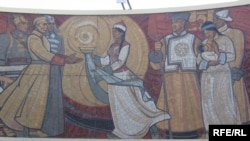RFE/RL correspondent Daisy Sindelar and multimedia producer Margot Buff are exploring Mongolia for a week. -- Eds.
On the southern outskirts of the Mongolian capital, Ulan Bator, you can find a surprising number of teenagers climbing a mountain of stairs to visit the Soviet-era war memorial depicting Mongolia's contributions to the victory in World War II. (At the foot of the stairs sits the Soviet tank where Russian President Dmitry Medvedev laid a wreath during his trip to the former Socialist bloc country last month. More than 18,000 Soviet and Mongolian soldiers died in a massive tank battle against the Japanese on the eve of the war.)
It's not the history that appears to attract the teenagers as much as the sweeping views and marathon climb up Zaisan Tolgoi hill, where they giggle and take photos with their friends, largely ignoring the monument itself.
A few kilometers away, teenagers flock to a different sort of place -- the Tse bar, which is bustling, sleek -- and fully decorated with Nazi memorabilia. SS uniforms are preserved in glass cases, propaganda posters line the walls, and everything from the entryway to the rest rooms is branded with swastika tiles.
"It's a fashion," says one girl nonchalantly as she checks her makeup in the mirror. (That's her in the second picture below.)
The patrons themselves look like university students anywhere, and seem largely oblivious to the surroundings. But local critics say Tse's design motif is just one symptom of the country's growing nationalism. Ultraright groups, who themselves often dress in Nazi garb, are gaining influence. So is their stated intent -- to "save" Mongolia by ridding it of Koreans, Vietnamese, and especially Chinese.
Attacks on Chinese laborers and vendors have been reported on the rise; Mongolian women accused of sleeping with Chinese men have reportedly had their heads shaved. One right-wing member, quoted in a local English-language daily, justified the measure, saying, "It's for their own good. A small nation can only survive by keeping its blood pure."
Nationalism is one thing; embracing Nazi emblems is another. (Holocaust scholars note that Nazis systematically selected Soviet prisoners of "Mongolian" features for execution.) Right-wing activists justify their tactics by saying Hitler was a devotee of Genghis Khan, and modeled the blitzkrieg after the Mongol warrior's own legendary conquests.
They also argue, accurately if disingenuously, that the swastika is of Buddhist origin. Indeed, Tse isn't the only place you can spot the symbol. It turns up everywhere in Ulan Bator -- on theater coat racks, fences, emblems, and even diplomas.
-- Daisy Sindelar
On the southern outskirts of the Mongolian capital, Ulan Bator, you can find a surprising number of teenagers climbing a mountain of stairs to visit the Soviet-era war memorial depicting Mongolia's contributions to the victory in World War II. (At the foot of the stairs sits the Soviet tank where Russian President Dmitry Medvedev laid a wreath during his trip to the former Socialist bloc country last month. More than 18,000 Soviet and Mongolian soldiers died in a massive tank battle against the Japanese on the eve of the war.)
It's not the history that appears to attract the teenagers as much as the sweeping views and marathon climb up Zaisan Tolgoi hill, where they giggle and take photos with their friends, largely ignoring the monument itself.
A few kilometers away, teenagers flock to a different sort of place -- the Tse bar, which is bustling, sleek -- and fully decorated with Nazi memorabilia. SS uniforms are preserved in glass cases, propaganda posters line the walls, and everything from the entryway to the rest rooms is branded with swastika tiles.
"It's a fashion," says one girl nonchalantly as she checks her makeup in the mirror. (That's her in the second picture below.)
The patrons themselves look like university students anywhere, and seem largely oblivious to the surroundings. But local critics say Tse's design motif is just one symptom of the country's growing nationalism. Ultraright groups, who themselves often dress in Nazi garb, are gaining influence. So is their stated intent -- to "save" Mongolia by ridding it of Koreans, Vietnamese, and especially Chinese.
Attacks on Chinese laborers and vendors have been reported on the rise; Mongolian women accused of sleeping with Chinese men have reportedly had their heads shaved. One right-wing member, quoted in a local English-language daily, justified the measure, saying, "It's for their own good. A small nation can only survive by keeping its blood pure."
Nationalism is one thing; embracing Nazi emblems is another. (Holocaust scholars note that Nazis systematically selected Soviet prisoners of "Mongolian" features for execution.) Right-wing activists justify their tactics by saying Hitler was a devotee of Genghis Khan, and modeled the blitzkrieg after the Mongol warrior's own legendary conquests.
They also argue, accurately if disingenuously, that the swastika is of Buddhist origin. Indeed, Tse isn't the only place you can spot the symbol. It turns up everywhere in Ulan Bator -- on theater coat racks, fences, emblems, and even diplomas.
-- Daisy Sindelar
